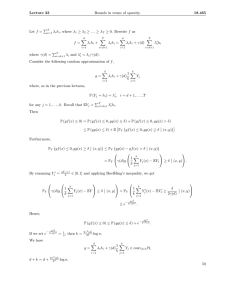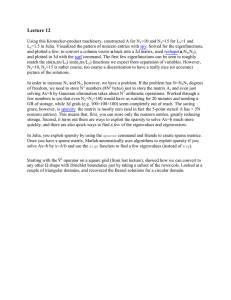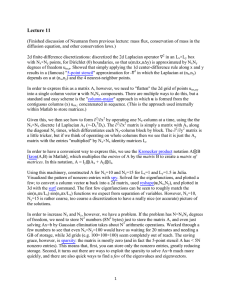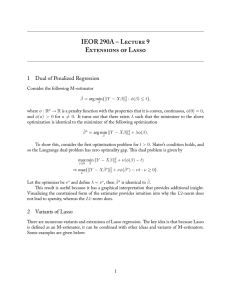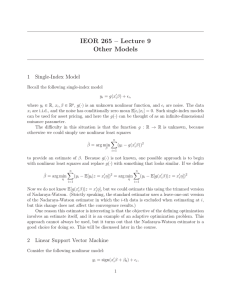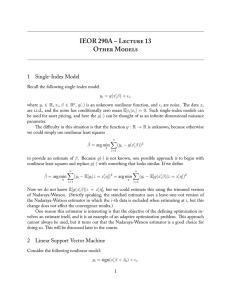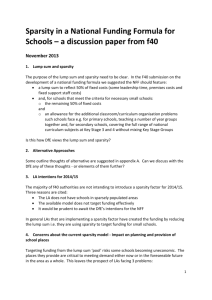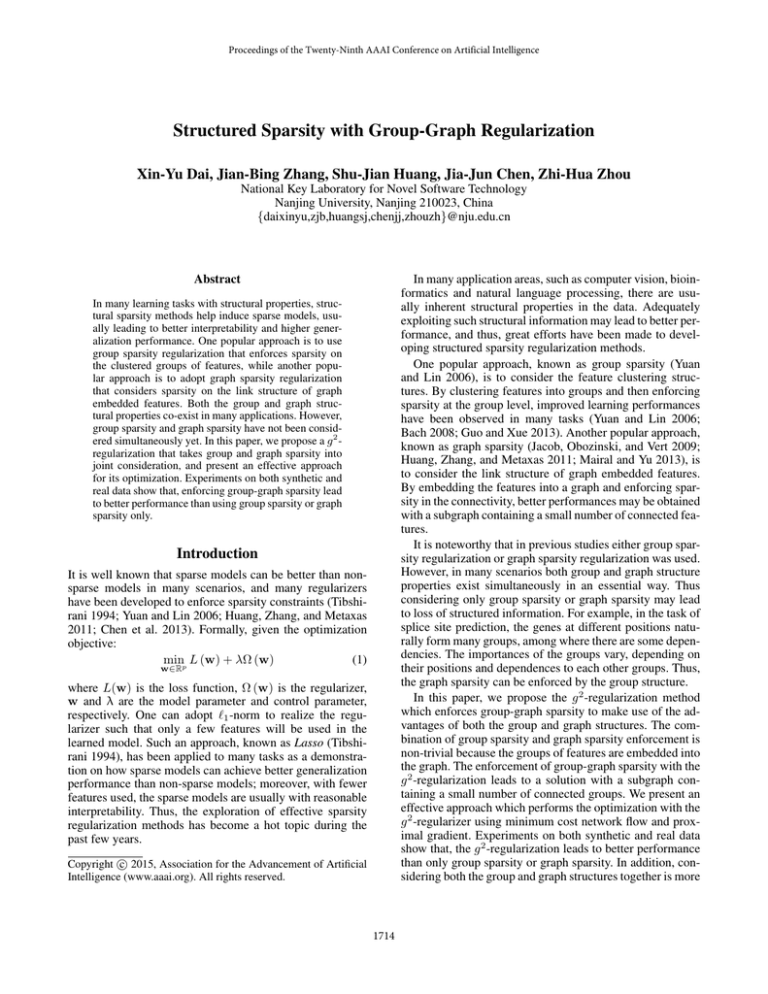
Proceedings of the Twenty-Ninth AAAI Conference on Artificial Intelligence
Structured Sparsity with Group-Graph Regularization
Xin-Yu Dai, Jian-Bing Zhang, Shu-Jian Huang, Jia-Jun Chen, Zhi-Hua Zhou
National Key Laboratory for Novel Software Technology
Nanjing University, Nanjing 210023, China
{daixinyu,zjb,huangsj,chenjj,zhouzh}@nju.edu.cn
Abstract
In many application areas, such as computer vision, bioinformatics and natural language processing, there are usually inherent structural properties in the data. Adequately
exploiting such structural information may lead to better performance, and thus, great efforts have been made to developing structured sparsity regularization methods.
One popular approach, known as group sparsity (Yuan
and Lin 2006), is to consider the feature clustering structures. By clustering features into groups and then enforcing
sparsity at the group level, improved learning performances
have been observed in many tasks (Yuan and Lin 2006;
Bach 2008; Guo and Xue 2013). Another popular approach,
known as graph sparsity (Jacob, Obozinski, and Vert 2009;
Huang, Zhang, and Metaxas 2011; Mairal and Yu 2013), is
to consider the link structure of graph embedded features.
By embedding the features into a graph and enforcing sparsity in the connectivity, better performances may be obtained
with a subgraph containing a small number of connected features.
It is noteworthy that in previous studies either group sparsity regularization or graph sparsity regularization was used.
However, in many scenarios both group and graph structure
properties exist simultaneously in an essential way. Thus
considering only group sparsity or graph sparsity may lead
to loss of structured information. For example, in the task of
splice site prediction, the genes at different positions naturally form many groups, among where there are some dependencies. The importances of the groups vary, depending on
their positions and dependences to each other groups. Thus,
the graph sparsity can be enforced by the group structure.
In this paper, we propose the g 2 -regularization method
which enforces group-graph sparsity to make use of the advantages of both the group and graph structures. The combination of group sparsity and graph sparsity enforcement is
non-trivial because the groups of features are embedded into
the graph. The enforcement of group-graph sparsity with the
g 2 -regularization leads to a solution with a subgraph containing a small number of connected groups. We present an
effective approach which performs the optimization with the
g 2 -regularizer using minimum cost network flow and proximal gradient. Experiments on both synthetic and real data
show that, the g 2 -regularization leads to better performance
than only group sparsity or graph sparsity. In addition, considering both the group and graph structures together is more
In many learning tasks with structural properties, structural sparsity methods help induce sparse models, usually leading to better interpretability and higher generalization performance. One popular approach is to use
group sparsity regularization that enforces sparsity on
the clustered groups of features, while another popular approach is to adopt graph sparsity regularization
that considers sparsity on the link structure of graph
embedded features. Both the group and graph structural properties co-exist in many applications. However,
group sparsity and graph sparsity have not been considered simultaneously yet. In this paper, we propose a g 2 regularization that takes group and graph sparsity into
joint consideration, and present an effective approach
for its optimization. Experiments on both synthetic and
real data show that, enforcing group-graph sparsity lead
to better performance than using group sparsity or graph
sparsity only.
Introduction
It is well known that sparse models can be better than nonsparse models in many scenarios, and many regularizers
have been developed to enforce sparsity constraints (Tibshirani 1994; Yuan and Lin 2006; Huang, Zhang, and Metaxas
2011; Chen et al. 2013). Formally, given the optimization
objective:
minp L (w) + λΩ (w)
(1)
w∈R
where L(w) is the loss function, Ω (w) is the regularizer,
w and λ are the model parameter and control parameter,
respectively. One can adopt `1 -norm to realize the regularizer such that only a few features will be used in the
learned model. Such an approach, known as Lasso (Tibshirani 1994), has been applied to many tasks as a demonstration on how sparse models can achieve better generalization
performance than non-sparse models; moreover, with fewer
features used, the sparse models are usually with reasonable
interpretability. Thus, the exploration of effective sparsity
regularization methods has become a hot topic during the
past few years.
c 2015, Association for the Advancement of Artificial
Copyright Intelligence (www.aaai.org). All rights reserved.
1714
g 2 -regularization
efficient than considering the graph structure only, because
the group structure will help reduce the graph structure to a
smaller scale.
In the following we start by presenting some preliminaries. Then we present the g 2 -regularization method, followed
by experiments and concluding remarks.
We now propose the g 2 -regularization which enforces
group-graph sparsity to make use of the group and graph
structures simultaneously. The group structure is embedded into a graph structure. g 2 -regularization leads to a solution with a subgraph containing a small number of connected groups. In this section, we firstly give the formulation of our g 2 -regularization. The optimization method with
g 2 -regularization is then presented.
Preliminaries
Group Sparsity
In group sparsity, we denote by I = {1, 2, ..., p} as the index
set of the model parameter w ∈ Rp in Eq.(1), then partition
it into groups. Each of the groups is denoted as Ai . So we
have
S a group structure π = {A1 , ..., Aq }, where (i). I =
A, (ii).Ai 6= ∅, ∀Ai ∈ π, (iii).Ai ∩ Aj = ∅, ∀Ai , Aj ∈
Formulation
We denote by I = {1, 2, ..., p} the index set of the model
parameter w ∈ Rp , and let π = {A1 , ..., Aq } the group
structure on I. Given a DAG G = (V, E) on the group index J = {1, 2, ..., q}, where V = J is the vertex set and
E = {(i, j) |i, j ∈ V } is the edge set. g = (v1 , v2 , ..., vk )
is a path in the graph of G, where vi ∈ V, i = 1, ..., k and
(vi , vi+1 ) ∈ E, i = 1, ..., k − 1. Let G denote the set of all
paths in graph G. ηg > 0 is non-negative weight of the path
g ∈ G. The formulation of g 2 -regularization is as follows:
X
[
∆
Ωg2 (w) = min
ηg s.t. Supp (σ (w)) ⊆
g
J ⊆G
A∈π
π, i 6= j. Group regularization is defined as follows:
ΩGroup (w) =
q
X
dj wAj 2
(2)
j=1
where wAj = hwi ii∈Aj is a sub-vector of the features in the
jth group, and dj is a nonnegative scalar for the group Aj .
The group sparsity is firstly proposed by (Yuan and
Lin 2006) as group lasso. The features are clustered into
pre-specified groups. Group lasso enforces sparsity at the
group level with `1 -norm regularization, so that features in
one group will either all be selected or all be discarded.
Many various methods (Roth and Fischer 2008; Meier,
van de Geer, and Buhlmann 2008; Liu, Ji, and Ye 2009;
Kowalski, Szafranski, and Ralaivola 2009) have been proposed for optimization with the group sparsity regularization.
g∈J
(4)
where Supp(·) stands for the nonzero index set of a vector.
J is a subset of G whose union covers the support of σ (w).
σ (·) is a group function σ : Rp → Rq which can be defined
as follows:
σ (w) = kwA1 k , kwA2 k , · · · , wAq (5)
where wAj = hwi ii∈Aj and k·k stands for the `2 -norm.
The above formulation is an extension of the graph
sparsity formulation. The features are firstly clustered into
groups, then a graph structure is constructed with the connectivity between groups. Our g 2 -regularization is applied
to select a subgraph with connected groups as supports.
Note that if the edge set E of G is an empty set, g 2 regularization will degenerate into group sparsity. If the
function is defined as σ : w → (|w1 | , ..., |wp |), g 2 regularization degenerates into graph sparsity. From this
point of view, our g 2 -regularization can be viewed as a natural combination of group sparsity and graph sparsity with
their two kinds of structures.
In addition, the group lasso can be rewritten as follows:
Graph Sparsity
In graph sparsity, we have a directed acyclic graph (DAG)
G = (V, E) on the index set I = {1, 2, ..., p} of the model
parameter w ∈ Rp , where V = I is the vertex set and
E = {(i, j) |i, j ∈ V } is the edge set. Let g be a path
in the graph of G, denoted as g = (v1 , v2 , ..., vk ), where
vi ∈ V, i = 1, ..., k and (vi , vi+1 ) ∈ E, i = 1, ..., k − 1. Let
G be the set of all paths in the graph G. We denote the positive weight of each path g ∈ G by ηg (ηg > 0). The graph
sparsity regularization is defined as follows (Huang, Zhang,
and Metaxas 2011):
X
[
ΩGraph (w) = min
ηg s.t. Supp (w) ⊆
g
J ⊆G
g∈J
g∈J
ΩGroup (w) = kσ (w)k1
g∈J
(3)
where Supp(·) stands for the nonzero index set of a vector.
J is a subset of G whose union covers the support of w.
The graph sparsity enforces us to select a subgraph J
containing a small number of connected features (That is to
cover Supp(w)).
Optimization with the graph sparsity regularization is not
exactly tractable when the graph scale is too large. Some
approximate optimization methods (Jacob, Obozinski, and
Vert 2009; Huang, Zhang, and Metaxas 2011; Mairal and
Yu 2013) have been proposed for graph sparsity.
(6)
Group lasso uses `1 -norm to select groups. However, we use
graph sparsity method to induce sparsity over groups which
forms the g 2 -regularization.
Optimization with g 2 -regularizer
The g 2 -regularizer (defined in Eq.(4)) can be rewritten as a
boolean linear program as follows:
T
∆
ΩConv (w) = min
η x s.t. Nx ≥ Supp(σ (w))
x∈{0,1}|G|
(7)
1715
Algorithm 1 The g 2 -regularization method
Input: Loss function L(w), group structure π, graph
structure DAG G0 , initial w0 , parameter λ, maximum iterations M , threshold τ
Output: wk
1: Compute ρ, a Lipschitz constant of ∇L (w)
2: Take y1 = w0 , t1 = 1, k = 1
repeat
3: ak ← yk − ρ1 · ∇L (yk )
P
fuv cuv
4: f ∗ ← arg min ρλ
f ∈F
which is an upper bound on the Lipschitz constant of ∇L.
(·)i stands for the ith entry of a vector. f stands for a network
flow on the graph G0 . F stands for the set of network flow f
∆ P
on G0 . sj (f ) = u∈V 0 :(u,j)∈E 0 fuj stands for the amount
of flow going through a vertex j.
We apply the proximal gradient method for optimization
under the FISTA (Beck and Teboulle 2009) algorithm implementation. Computing the proximal operator in step 4
and 5 is equivalent to computing network flow inspired by
(Mairal and Yu 2013). Theorem 1 shows the equivalence
of proximal operator of ΩConv in Eq.(8) and network flow
problem computed in step 4 and step 5. (The proof is attached in supplemental material.)
(u,v)∈E 0
2
max (σ (ak ))j − sj (f ) , 0
sj (f ∗ )
(a
)
, i ∈ Aj ,
5: (wk )i ← min (ak )i , (σ(a
k
i
))
k
+
Pq
1
j=1 2
Theorem 1. For b ∈ Rp , here, the group function σ, and
graph G0 with costs [cuv ]uv∈E 0 are defined above. The proximal operator of ΩConv (w):
1
2
ProxΩConv (b) = arg min kb − wk +ΩConv (w) (10)
p
2
w∈R
is equivalent to compute:
!
sj (f ∗ )
∗
bi , i ∈ Aj , ∀j ∈ {1, ..., q}
wi = min bi ,
(σ (b))j
(11)
where
(
P
f ∗ ∈ arg min
fuv cuv
f ∈F
(u,v)∈E 0
)
2
q
P
1
+
2 max (σ (b))j − sj (f ) , 0
j
j ∈ {1, 2, ..., q}
√
6: tk+1 ←
1+4t2k
2 −1
wk + ttkk+1
(wk
1+
7: wk+1 ←
8: k ← k + 1
− wk−1 )
until |wk−1 − wk−2 | < τ or M iterations finish.
|G|
where η([ηg ]g∈G ) is the vector in R+ , and N is a binary maq×|G|
trix in {0, 1}
which indicates if each vertex is in each
q
path of G or not. Supp(σ (w)) is a vector in {0, 1} such that
its jth entry is one if j is in the support of σ (w) or zero if
not.
Since the g 2 -regularizer defined in the Eq.(7) is nonconvex, we can now formulate a convex relaxation of
ΩConv (w):
∆
ΩConv (w) = min ηT x s.t. Nx ≥ |σ (w)|
(8)
j=1
(12)
It is easy to see that Eq.(8) is a norm. Hence, according to
previous studies (Nesterov 2007; Beck and Teboulle 2009),
the solution will converge to the solution of Eq.(1) when we
use the proximal gradient method with a convex regularization. The complexity of solving Eq.(12) with an ε-accurate
solution is a time polynomial in |E|, |V |, log (kσ (b)k∞ /ε).
In our method, the groups are viewed as nodes, |V | is consequently reduced to a small scale. As the number of node
decreases, the number of edge decreases accordingly. This
shows that |E| and |V | become small. So, as for optimization, it is more efficient with the g 2 -regularization since the
graph structure can be reduced to a reasonable scale with the
help of group structure.
|G|
x∈R+
Such a relaxation is classical and corresponds to the same
mechanism relating the `0 to the `1 -penalty. |σ (w) | is the
|G|
vector in R+ obtained by replacing the entries of σ (w) by
their absolute values.
In Algorithm 1, we present an effective optimization approach with the g2-regularizer in Eq.(8) using minimum cost
network flow and proximal gradient.
The weight of a path is the sum of the costs of all edges
on this path. Denote s and t as two additional nodes which
stand for the source and sink node on graph G. Define
G0 = (V 0 , E 0 ) as V 0 = V ∪ {s, t} and E 0 = E ∪
{(s, u) |u ∈ V } ∪ {(u, t) |u ∈ V }. We denote by cuv the
cost of the edge uv ∈ E 0 where uv stands for (u, v) for
short. For a path g = (v1 , v2 , · · · , vk ), the weight ηg is computed as follows:
Xk−1
ηg = csv1 +
cvi vi+1 + cvk t
(9)
Error Bound Analysis
In this subsection, we discuss the estimation error bound of
our g 2 -regularization to illustrate the benefits of constructing
a graph structure on groups.
According to previous study (Huang and Zhang 2010) ,
the parameter estimation error bound of group lasso is defined as follows:
√
p
4.5
√ 1 + 0.25τ−1
κD2 + αB 2
kwest − w̄k ≤
ρ− (s) n
(13)
i=1
The loss function L is convex and differentiable with a
Lipschitz continuous gradient. Here ρ > 0 is a parameter
1716
and
Table 1: Relative difference (r) of g 2 -regularization and
other sparsity regularizations.
g2 Graph
Group Lasso
regularization sparsity Lasso
r (×10−4 )
1.8
2.2
4.0
5.9
lD2 + αl B 2
72 (κD2 + αB 2 )
where w̄ is a (α, κ) strongly group-sparse ground-truth.
wset is the estimated parameter. D, B are two constant
scalars depending on the data. s and l are two constant
scalars depending on κ. n is the number of samples. ρ− (s)
is the group sparse eigenvalue, also defined in (Huang and
Zhang 2010). αl stands for the minimum group number
where the size of the union of these groups is larger than
l.
In g 2 -regularizer, we have a graph structure (DAG) on
groups, this can be seen as a kind of overlap group lasso
(each overlapped group can be seen as a union of some
groups), which has a very small α (Jenatton, Audibert, and
Bach 2011). Thus, we have a small τ−1 . Besides, after the
construction of the graph structure on the groups, ρ− (s) will
remain the same. These two aspects show that we can get a
smaller bound from the graph structure.
Moreover, Huang, Zhang, and Metaxas( 2011) uses the
coding complexity to interpret the structured sparsity. The
parameter estimation error bound depends on the coding
length. The bound grows with the increasing of coding
length. From this theory, if the regularizer is defined as the
graph sparsity (Eq.(3)), for a subset K ⊆ I = {1, 2, ..., p},
the suggested coding length cl (K) is computed as follows
τ2 ≤
cl (K) = C |K| + θlog2 p
(a) g 2 -regularization
(b) Graph sparsity
(c) Group lasso
(d) Lasso
Figure 1: Plot west − w̄ to analysis the parameter estimation
of different methods
(14)
property. We generate 500 data points (xi , yi ) where each
point has 1000 features. These features are divided into 100
groups (each group has 10 features) . The features in the
first 10 groups are selected as the support of w. Each
yi is
computed by yi = wT xi + ε, where ε ∼ N 0, σ2 and σ
is Gaussian-distributed noise. We use Least Square as the
2
loss function L (w) = kY − Xwk .
Following the comparison method presented by (Huang,
Zhang, and Metaxas 2011), we use relative difference r =
kwest − w̄k2 /kw̄k2 for comparison, where w̄ and west
stand for the ground-truth and the estimated parameter, respectively. In this experiment, the graph structure over these
100 groups is generated as follows:
where C is a constant. θ stands for S
the number of connected
θ
parts of K on a graph, i.e. K = i=1 Ki and each Ki is
connected.
In our g 2 -regularization method, nodes on the graph are
composed of groups. So, for K ⊆ I = {1, 2, ..., p}, the
coding length cl (K) of g 2 -regularization can be computed
as follows:
0
C |Q| + θ0 log2 q
cl (K) =
(15)
∞, K is not a union of groups
where C 0 is a constant. Q is a subset of J = {1, 2, ..., q}.
Each element in Q stands for one node (i.e. one group) in
the graph G. |Q| stands for the number of the groups in K.
θ0 is the number of connected part of Q on the graph, i.e.
Sθ0
Q = i=1 Qi and Qi is connected. Since q is smaller than
p, this coding length is smaller than that of graph sparsity
defined in Eq. (14).
Above analysis shows that we can obtain smaller estimation error bound with g 2 -regularization than considering
group or graph sparsity only.
• The Group and Graph Structures: Based on the priori
properties, we generate a graph where the first 10 groups
are connected as a path and the cost of each edge on this
path is −0.05. Other groups are isolated in the graph. For
the edges of the source node s and the sink node t, we set
{csu = 0 |u ∈ V } and {cut = 1 |u ∈ V }
We compare the relative difference of our g 2 regularization method with Lasso, group lasso and
graph (without group) sparsity . The group structure used
in the group lasso is exactly the same as that used in the
g 2 -regularizer. As for graph (without groups) sparsity, we
construct a graph where the first 100 features are connected
and the cost of each connected edge is −0.005. Other
features are isolated in this graph.
Based on the exact group and graph structural properties,
Table 1 shows that our method gets the best result comparing
with any of the other methods.
Experiments
We use synthetic and real data to evaluate the g 2 -regularizer.
A modified open-source software named SPAMS from http:
//spams-devel.gforge.inria.fr/ is used to implement our algorithm.
Synthetic Data
Firstly, we use the synthetic data to evaluate our method
when the graph structure over groups is given as a priori
1717
with factor interactions. In 5’ case, a DNA sequence is modeled within a window from −3 to 5 as in Figure 2. Removing the consensus sequence ‘GT’ results in sequences
of length 7, i.e., sequences of 7 factors with 4 levels {A, C,
G, T }. The Sequences Logo in Figure 2 are represented as
a collection of all factor interactions up to order 4, such as
{(−2), (−1, ), (2), ...} of 1st -order, {(−2, −1), (−2, 2), ...}
of 2nd -order, and so on. Each interaction is treated as a
group, leading to 98 groups that include 7 groups of 1st order, 21 groups of 2nd -order, 35 groups of 3rd -order, and
35 groups of 4th -order. The dimension of feature space
is 11564. In 3’ case, with the same setup, we have 1,561
groups. The dimension of feature space is 88, 564.
Secondly, according to the order, all groups are partitioned into four lists (1st -order, 2nd -order, 3rd -order
and 4th -order) in 5’ case. The groups in each list
are with the same size. In each list, the groups are
sorted by the dictionary order of factors, such as
((−2, −1), (−2, 2), (−2, 3), ...). Two adjacent groups are
linked from lower rank to higher rank. The edges between
these adjacent groups are set with a cost of 10.
The splice site data have the properties that the groups
close to the consensus pair ‘GT’ or ‘AG’ are considered to
be more dependent (Yeo and Burge 2004). Consensus ‘GT’
(or ‘AG’) is a pair which appears in both the true and false
samples at a fixed position in 5’ case (or in 3’ case). According to above data properties, in each list, the concentrated
groups around the consensus pair are linked in 5’ case (or
3’ case). So, we link 1st -order groups of (−2, −1, 2, 3) together, and 2nd -order groups ((−2, −1), (−1, 2), (2, 3)) together, etc. These edges are set with a small cost of 0.1.
For the edges connecting the source and sink nodes s and
t, we set {csu = 0 |u ∈ V } and {cut = 1 |u ∈ V }. As for
the graph sparsity without groups, we use the similar graph
structure except that we link all the inner group features.
The above graph construction processes is far from optimal; however, it is sufficient to be used in our experiments,
though a better graph may lead to a better performance.
(3) Results We use the Maximum Correlation Coefficient
(MCC) and Receiver Operating Curve(ROC) as two performance measures. The detailed description of MCC and ROC
is attached in the supplement material of this paper.
We randomly partition the data into the training and test
sets for 10 times, and report the average results as well as
standard deviations over the 10 repetitions. In Table 2, we
compare the g 2 -regularization with `1 -norm and the group
lasso regularizations. Our method is significantly better than
the other methods based on the t-test at 95% significance
level in both 5’ case and 3’ case. Group structure can help
enforce sparsity on the group level, but it is still not enough
to represent the linked structure in the feature space. When
we make additional use of the graph structures on groups,
the performance is improved significantly.
In Table 2, please note that results of graph sparsity without groups cannot be obtained within 24 hours or longer,
since the scale of the graph is too dense and large to be optimized. However, our g 2 -regularization can obtain results
within about 20.9 seconds in 5’ case and 201.2 seconds in 3’
case. It works efficiently because the group structure helps to
Figure 2: Sequence Logo representation of the 5’ splice site
case. It is modeled within a window from −3 to 5. The consensus ‘GT’ appears at positions 0, 1.
Moreover, in order to show the robust of the g 2 regularization, we generate a random graph structure. The
result of relative difference from the random graph is also
4.0, which is still comparable with group lasso.
In Figure 1, we further analyze the parameter estimation of the different regularizations. The g 2 -regularization,
group lasso and graph sparsity (Fig. 1(a)-1(c)) can select features more accurately than Lasso (Fig. 1(d)). Graph-based
sparsity regularization methods (Fig. 1(a) and 1(b)) do better than group lasso(Fig. 1(c)). It is noteworthy that the g 2 regularization (Fig. 1(a)) selects the features with a smaller
deviation than the graph sparsity regularization without the
group structure (Fig. 1(b)). This further analysis illustrates
that the combination of the group and graph structures is
better than using the graph or group structure only.
Application on Splice Site Prediction
In order to evaluate the performance of our method on realworld applications, we apply our method to two splice site
prediction datasets, MEMset and NN269 dataset. Splice site
prediction plays an important role in gene finding. The samples of splice site prediction data are sequences of factors
with 4 levels {A, C, G, T }.
MEMset Dataset (1) Experiment Setup This dataset is
available at http://genes.mit.edu/burgelab/maxent/ssdata/.
It can be divided into two cases: 5’ splice site case and
3’ splice site case. In 5’ case, the sequences have length 7
with 4 level {A, C, G, T }, while in 3’ case, the sequences
have length 21 with the same 4 level. More information
about this dataset can be found in (Yeo and Burge 2004).
MEMset is a very unbalanced dataset. In our experiments,
we randomly choose a balanced subset with 6000 true and
6000 false donor splice sites for evaluation in 5’ case and in
3’ case, respectively. We use the logistic Regression loss
N
P
T
log 1 + e−yi x xi . In addition, we
function L (w) =
i=1
randomly choose another 600 true and 600 false splice sites
as validation data in 5’ case and 3’ case, respectively. The
control parameter of λ in Eq.1 is tuned on the validation
data.
(2) The Group and Graph Structures Identified in previous
study (Roth and Fischer 2008), features are firstly grouped
1718
Table 2: Maximum correlation coefficient(MCC, mean±std.) of the g 2 -regularization and other methods on the MEMset and
NN269 dataset. N/A stands for no results obtained within 24 hours.
`1 regularizer
Group sparsity
g 2 -regularization
Graph sparsity
MEMset - 5’case
0.8716±0.0102
0.8847±0.0113
0.9267±0.0071
N/A
MEMset - 3’case
0.8215 ±0.0162
0.8285±0.0139
0.8577±0.0179
N/A
NN269 - 5’case
0.8711±0.0205
0.8920±0.0238
0.9436±0.0238
N/A
NN269 - 3’case
0.8203±0.0213
0.8312±0.0226
0.8508±0.0185
N/A
Figure 3: ROC for `1 -norm, Group Lasso, and g 2 regularization on MEMset, 5’ case and 3’ case, respectively.
Figure 4: ROC curves for `1 -norm, Group Lasso, and g 2 regularization on NN269, 5’ case and 3’ case, respectively.
reduce the graph structure to a smaller scale. We have only
98 and 1561 groups (nodes in the graph) in 5’ case and 3’
case, respectively.
In addition to MCC, we applied another measure of ROC
for evaluation with a view to illustrating the performance in
a binary classifier hypothesis test. In Figure 3, g 2 regularization shows the best performance where the two solid curves
(5’ case and 3’ case, respectively) are closer to the left and
top borders.
with long range interactions. According to above structural
properties, we use a connected DAG with cost 0.1 for each
edge. We set {csu = 0 |u ∈ V } and {cut = 1 |u ∈ V }. Finally, we have 54 groups with 4188 features in 5’case and
354 groups with 29688 features in 3’ case. For the graph
sparsity without groups, we use a connected DAG on the
each feature, and the cost of each edge is similar with that in
g 2 -regularization.
(3) Results We randomly partition the data into the training
and test sets for 10 times, and report the average results as
well as standard deviations over the 10 repetitions. As shown
in Table 2, the performance of using the g 2 regularization is
significantly better compared with the `1 -norm and group
lasso based on the t-test at 95% significance level in both 5’
case and 3’ case. Through ROC measures, g 2 -regularization
also shows the best performance in NN269 dataset, as shown
in Figure 4.
NN269 Dataset (1) Experiment Setup We use the NN269
dataset for more real-world data evaluation (Reese et al.
1997), which is available at http://www.fruitfly.org/data/seq
tools/datasets/Human/GENIE 96/splicesets/.
It can also be divided into two cases: the 5’ splice site and
the 3’ splice site. In 5’ case, the sequences have length 15
with 4 level {A, C, G, T }, while the sequences in 3’ case
have length 90 with 4 level {A, C, G, T }. It is not so unbalanced of NN269 dataset. Thus, in 5’ case, we directly use the
dataset with 1116 true and 4140 false donor sites for evaluation (another 208 true and 782 false donor site for validation). In 3’ case, we use the dataset with 1116 true and 4672
false acceptor sites for evaluation (another 208 true and 881
false sites for validation). The control parameter of λ in Eq.1
is tuned on the validation data.
(2) The Group and Graph Structures The sequence length
in this dataset is much longer than that in the MEMset, especially in 3’ case. Using all the factor interactions up to
order 4 will lead to more than 2.5 million groups. So, in
the NN269 dataset, only succession interactions up to order
4 are grouped in both 5’ and 3’ case. The graph structure
is then used to model the long range interactions. Several
small groups in one path could be viewed as a big group
Conclusions
In this paper, we propose a new form of structured sparsity
called g 2 -regularization. Theoretical properties of the proposed regularization are discussed. With the graph structures
on groups, we apply the minimum network flow and proximal gradient method for the optimization. Experiments on
both synthetic and real data demonstrate its superiority over
some other sparse or structured sparse models. In the future, we will explore the graph structure with more inherent
structural properties in data. Further research will be conducted to find more efficient optimization method on largescale graph.
1719
References
Yuan, M., and Lin, Y. 2006. Model selection and estimation
in regression with grouped variables. Journal of the Royal
Statistical Society. Series B 68(1):49–67.
Bach, F. 2008. Consistency of the group lasso and multiple kernel learning. Journal of Machine Learning Research
9:1179–1225.
Beck, A., and Teboulle, M. 2009. A fast iterative shrinkagethresholding algorithm for linear inverse problems. SIAM
Journal on Imaging Sciences 2(1):183–202.
Chen, S.-B.; Ding, C.; Luo, B.; and Xie, Y. 2013. Uncorrelated lasso. In Proceedings of the Twenty-Seventh AAAI
Conference on Artificial Intelligence, 166–172.
Guo, Y., and Xue, W. 2013. Probabilistic multi-label classification with sparse feature learning. In Proceedings of
the Twenty-Third International Joint Conference on Artificial Intelligence, 1373–1380.
Huang, J. Z., and Zhang, T. 2010. The benefit of group
sparsity. Annals of Statistics 38(4):19782004.
Huang, J. Z.; Zhang, T.; and Metaxas, D. 2011. Learning
with structured sparsity. Journal of Machine Learning Research 12:3371–3412.
Jacob, L.; Obozinski, G.; and Vert, J.-P. 2009. Group lasso
with overlap and graph lasso. In Proceedings of the 26th
International Conference on Machine Learning, 433–440.
Jenatton, R.; Audibert, J.-Y.; and Bach, F. 2011. Structured
variable selection with sparsity-inducing norms. Journal of
Machine Learning Research 12:2777–2824.
Kowalski, M.; Szafranski, M.; and Ralaivola, L. 2009. Multiple indefinite kernel learning with mixed norm regularization. In Proceedings of the 26th International Conference
on Machine learning, 545–552.
Liu, J.; Ji, S. W.; and Ye, J. P. 2009. Multi-task feature learning via efficient l2,1-norm minimization. In Uncertainty in
Artificial Intelligence (UAI), 339–348.
Mairal, J., and Yu, B. 2013. Supervised feature selection in
graphs with path coding penalties and network flows. Journal of Machine Learning Research 14:2449–2485.
Meier, L.; van de Geer, S.; and Buhlmann, P. 2008. The
group lasso for logistic regression. Journal of the Royal Statistical Society. Series B 70(1):53–71.
Nesterov, Y. 2007. Gradient methods for minimizing composite objective function. Technical report, Technical report,
CORE Discussion paper.
Reese, M. G.; Eechman, F. H.; Kulp, D.; and Haussler, D.
1997. Improved splice site detection in genie. Journal of
Computational Biology 4(3):311–324.
Roth, V., and Fischer, B. 2008. The group-lasso for generalized linear models: uniqueness of solutions and efficient.
In Proceedings of the 25th International Conference on Machine learning, 848–855.
Tibshirani, R. 1994. Regression shrinkage and selection via
the lasso. Journal of the Royal Statistical Society. Series B
58(1):267–288.
Yeo, G., and Burge, C. B. 2004. Maximum entropy modeling of short sequence motifs with applications to rna splicing signals. Journal of Computational Biology 11(2/3):377–
394.
1720

